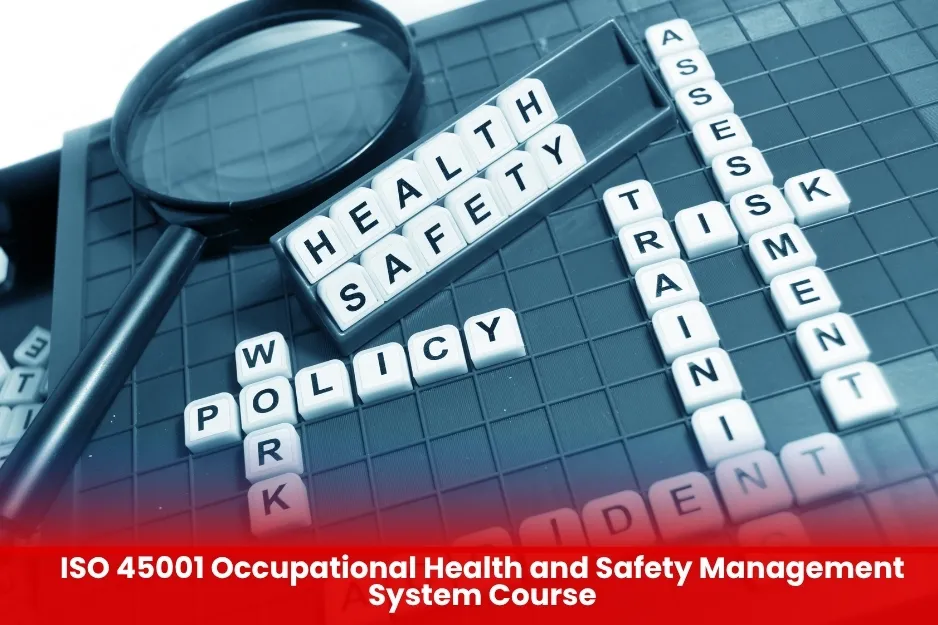ISO 45001 Occupational Health and Safety Management System Course
ISO 45001 is an international standard that sets out the requirements for an Occupational Health and Safety Management System (OHSMS). It provides a structured framework to help organizations improve employee safety, reduce workplace risks, and create healthier working conditions.

Aim of ISO 45001 Occupational Health and Safety Management System
Provide a systematic framework for managing occupational health and safety (OH&S) risks and opportunities in order to prevent work-related injury and ill health, and to create safer, healthier workplaces.
Course Overview
ISO 45001 Occupational Health and Safety Management System Course
Total Modules 6
Training Credits 12
Directed Learning Hours (DLH) 90
Course Code BUK1933
- Identify workplace hazards, risks, and opportunities.
- Involve workers and ensure participation and consultation.
- Comply with applicable legal and regulatory requirements.
- Implement necessary controls, procedures, and documentation.
- Undergo a third-party audit by an accredited certification body.
| Course Code | Curriculum Title | Credit | DLH |
|---|---|---|---|
| BUK1933-1 | Context of the Organization | 2 | 15 |
| BUK1933-2 | Leadership and Worker Participation | 2 | 15 |
| BUK1933-3 | Planning | 2 | 15 |
| BUK1933-4 | Operation | 2 | 15 |
| BUK1933-5 | Performance Evaluation | 2 | 15 |
| BUK1933-6 | Improvement | 2 | 15 |
Learning Objectives
- Context of the Organization
- Understand internal and external OH&S issues
- Identify interested parties (e.g., workers, regulators, contractors)
- Define the scope of the OH&S Management System
- Determine how these factors affect the organization’s ability to achieve its intended outcomes
- Leadership and Worker Participation
- Top management commitment to OH&S
- Establish an OH&S policy
- Assign roles, responsibilities, and authorities
- Ensure worker consultation and participation in the system
- Promote a safety culture at all levels
- Planning
- Identify hazards, risks, and opportunities
- Assess legal and regulatory requirements
- Define OH&S objectives and planning to achieve them
- Integrate risk controls and change management
- Support
- Provide resources (people, infrastructure, technology)
- Ensure worker competence, training, and awareness
- Manage communication (internal and external)
- Control and maintain documented information (e.g., procedures, policies)
- Operation
- Plan, implement, and control operational processes
- Manage change safely
- Eliminate hazards and reduce OH&S risks
- Ensure safety in outsourced processes and contractors
- Prepare for and respond to emergencies
- Performance Evaluation
- Monitor, measure, analyze, and evaluate OH&S performance
- Conduct internal audits
- Perform management reviews
- Ensure compliance with legal and other requirements
- Improvement
- React to incidents and nonconformities
- Implement corrective actions
- Promote a cycle of continual improvement in the OH&S system
- Private companies (small, medium, large enterprises) across all industries
- Public sector organizations and government departments
- Non-governmental organizations (NGOs)
- Educational institutions (schools, colleges, universities)
- Healthcare providers (hospitals, clinics)
- Construction firms, manufacturing plants, transportation services
- Service providers (hotels, retail, IT, finance)
- Event organizers and contractors
- Any workplace with employees, contractors, visitors, or volunteers
- All Modules within this qualification are assessed internally by the approved training Centre and externally verified by BURRAQ UK. The program uses a criterion-referenced assessment approach to ensure that learners successfully meet all required learning outcomes.
- A Pass in any unit is granted only when the learner submits valid, reliable, and authentic evidence that demonstrates achievement of the assessment criteria. The Assessor is responsible for reviewing this evidence and confirming that the learner has attained the expected standard.
